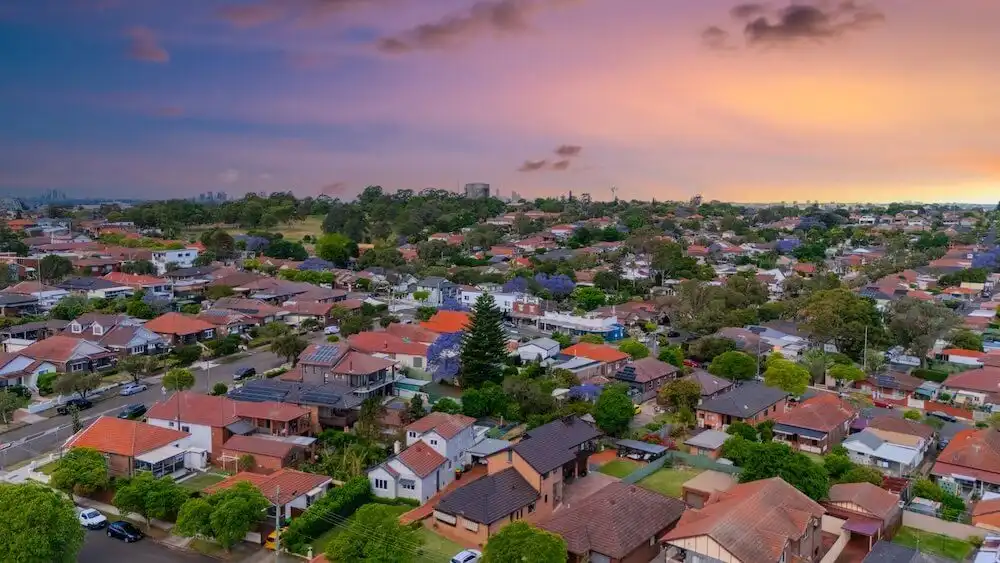Property price growth ramps up again as spring arrives
August saw Australian home values rise for a sixth consecutive month ahead of the spring selling season, according to CoreLogic's latest report.
The pace of growth accelerated slightly despite another uptick in new listings, once again demonstrating the depth of buyer demand in what seems to be a seller's market.
With spring beginning in earnest, can that momentum carry on through the warmer months?

Get a free property value estimate
Find out how much your property is worth in today’s market.
National property prices: August 2023
Australia's median home price rose another +0.8 per cent in August, a slight increase from July's +0.7 per cent growth.
That means property values have risen a full +4.9 per cent from the national low-point in February.
| Market | Month | Quarter | Annual | Median value |
|---|---|---|---|---|
| Sydney | 1.1% | 3.8% | 1.2% | $1,098,821 |
| Melbourne | 0.5% | 1.6% | -2.3% | $768,216 |
| Brisbane | 1.5% | 4.2% | -3.0% | $747,626 |
| Adelaide | 1.1% | 3.4% | 2.2% | $682,642 |
| Perth | 0.9% | 2.9% | 4.5% | $607,083 |
| Hobart | -0.1% | -0.5% | -10.0% | $657,487 |
| Darwin | 0.8% | 1.6% | -1.3% | $496,136 |
| Canberra | 0.3% | 0.5% | -5.9% | $830,875 |
| Combined capitals | 1.0% | 3.1% | -0.1% | $804,152 |
| Combined regional | 0.1% | 0.8% | -4.0% | $588,841 |
| Australia | 0.8% | 2.5% | -1.1% | $732,886 |
Sydney ramped up again with gains of +1.1 per cent for the month, while Melbourne also regained some strength by clocking a +0.5 per cent uptick.
A massive +1.5 per cent increase for Brisbane pushed the median price towards $750,000, and gains of +1.1 per cent for Adelaide and +0.9 per cent for Perth again brought both cities to new all-time highs.
Hobart remained relatively flat with a minor dip of -0.1 per cent, Darwin recovered further with +0.8 per cent growth, and Canberra returned to positive territory with +0.3 per cent.
Regional markets were still a mixed bag but on the whole saw prices notch up by +0.1 per cent over August.
Zooming out, CoreLogic's Research Director, Tim Lawless, noted that "Sydney has led the recovery trend to date with a gain of +8.8 per cent since values found a floor in January this year. Brisbane has also posted a strong recovery with values up +6.2 per cent since bottoming out in February."
He added that "At the other end of the scale, some other capital cities are better described as flat, with Hobart home values unchanged since stabilising in April, while values across the ACT have risen only mildly, up 1.0% since a trough in April."
New listings continue to rise but so too does demand
In July we saw new listings rise above five-year average levels for the first time since September 2022, seemingly breaking a long supply drought that drove the strong price recovery.
That trend continued in August. Mr Lawless commented, "We have seen vendors becoming more active though winter, which is seasonally unusual."

With many sellers looking to capitalise on strong selling conditions and get a head start on spring, new listings were +3 per cent higher than in August 2022 and +13 per cent above the five-year average.
Despite having a fresh wave of purchasing options, buyers moved swiftly to snap up new listings. As a result, total stock on the market remained well below average levels.

"Most of this fresh stock is being absorbed by the market, with the count of total capital city listings rising by only +3.6 per cent over the past two months, despite the flow of new listings jumping +12.9 per cent," Mr Lawless said.
The ACT, Sydney and Melbourne saw the most significant uptick in new listings, while the Perth, Adelaide and Brisbane markets remained especially tight.
Mr Lawless noted that "The balance between advertised supply and demonstrated demand will be a key factor influencing housing market outcomes in spring," saying demand would need to remain strong if substantial price growth was to continue.
Regional markets are delivering mixed results
Every state regional market outperformed its capital city counterpart throughout the 2021 property boom, delivering staggering growth — in some cases more than +50 per cent.
Those regional markets have broadly seen a more muted recovery than the capitals in 2023, though.

On the one hand, regional South Australia and Western Australia both remain at or around all-time highs, and regional Queensland has seen strong growth pushing prices back towards peak levels.
However, things have been a bit more sluggish in NSW, Victoria and Tasmania.
| Market | Month | Quarter | Annual | Median value |
|---|---|---|---|---|
| Regional NSW | -0.2% | 0.1% | -7.1% | $700,402 |
| Regional VIC | -0.6% | -1.4% | -7.4% | $561,337 |
| Regional QLD | 0.8% | 2.5% | -1.0% | $577,631 |
| Regional SA | 0.9% | 3.1% | 9.5% | $385,310 |
| Regional WA | 0.1% | 0.1% | 3.9% | $437,201 |
| Regional TAS | 0.0% | -0.4% | -5.2% | $505,617 |
| Combined capitals | 1.0% | 3.1% | -0.1% | $804,152 |
| Combined regional | 0.1% | 0.8% | -4.0% | $588,841 |
"With internal migration trends normalising across regional Australia, and less demand side pressures from net overseas migration than in capital cities, regional markets generally aren’t seeing the same level of recovery," Mr Lawless said.
He noted that historic ABS data shows that only about 15 per cent of overseas migrants land in regional areas, so the considerable population growth we've seen in 2023 so far isn't having such a big impact on regional markets.
Instead, domestic migration is more key in elevating certain regional areas that have strong lifestyle appeal. This frequently includes coastal areas like the Sunshine Coast and Gold Coast as well as regions within commuting distance of the capitals.
What's next for Australian property?
With inflation now looking to be coming under control, each month seems to strengthen economists' opinions that the risk of further interest rate hikes is far lower.
Eyes are now shifting away from the RBA and instead towards the supply and demand dynamic that unfolds this spring selling season to help gauge where property prices go from here.
CoreLogic's report described the housing market recovery as "firmly entrenched" thanks to six consecutive months of price increases, but "some headwinds remain apparent."
The leading headwind could be rising listings, particularly if buyer demand can't keep up as it has over the past two months.
Eleanor Creagh, Senior Economist at PropTrack, suggested in a recent newsletter that stretched affordability could once again work to slow down the rate of price growth seen so far in 2023.
"But high levels of migration coupled with lower new supply and an emergent housing shortfall is likely to continue to cause prices to lift despite affordability remaining stretched," she said.
"However, price growth is likely to remain stronger in the smaller capital city markets of Perth, Adelaide and Brisbane where housing is comparatively affordable, with demand bolstered by both interstate and overseas migration."
1. CoreLogic News, 'Home Value Index shows housing recovery gains momentum in August as national home values rise 0.8%', 1 September 2023
https://www.corelogic.com.au/news-research/news/2023/home-value-index-shows-housing-recovery-gains-momentum-in-august-as-national-home-values-rise-0.8
2. PropTrack Newsletter, 'Prices are approaching a new peak - so how big was the downturn really?', 1 September 2023






